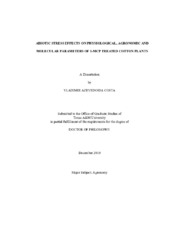| dc.description.abstract | Abiotic stresses impact cotton (Gossypium hirsutum L.) affecting physiological,
molecular, morphological, and agronomic parameters. One of the main yield
components in cotton production is the number of bolls per unit area. However, boll
abortion is increased when cotton experiences various stresses during its reproductive
development that can consequently reduce lint yield. Prior to abscission, a burst in
ethylene is observed which may be assumed to be the signal necessary to initiate
abscission of that particular structure. It is desirable to prevent fruit loss that may be
induced by the peak in ethylene prior to abscission. One potential option to cope with the
loss of cotton reproductive structures is the use of ethylene inhibitors. The overall
objective of this research was to establish if 1-MCP would synergize, ameliorate, or
overcome the effects of abiotic stresses on physiological, molecular, morphological, and
agronomic parameters of cotton plants under abiotic stress conditions in field and
greenhouse studies. Field and greenhouse experiments were conducted from 2007 to
2009 as a randomized complete block design with four replications in the field, and as a 2x2 factorial design in a split-block arrangement with five replications in the
greenhouse. Field treatments consisted of three rates of 1-MCP (0, 25 and 50 g a.i. ha-1)
in combination with a surfactant applied at mid-bloom. One day later, ethephon
(synthetic ethylene) was applied as a source of abiotic stress. Greenhouse treatments
were two 1-MCP rates (0 and 2.4 g a.i. L-1) during a14-h overnight incubation that were
then subjected to two water regimes (control and stressed) as the source of stress.
Greenhouse assessments with gas exchange analysis revealed that water deficit stress
started to impact plants at a moderate water stress, 5 days after 1-MCP treatment (DAT)
and a water potential (ψw) of -1.4 MPa. The 1-MCP increased water use efficiency in
well-watered plants at 1 DAT. Many of the yield components, plant mapping, and
biomass parameters investigated were detrimentally affected by drought. However,
drought increased specific leaf weight, chlorophyll content, and harvest index. The 1-
MCP improved reproductive node numbers mainly during drought, but did not lead to a
better harvest index, since 1-MCP caused high abscission. Ethylene synthesis and
molecular investigations in greenhouse conditions showed that at 1, 5, 7, 9, 11, and 13
DAT, ethylene production of stressed plants never exceeded those of control plants. As
the ψw became more negative ethylene production rate was reduced among stressed
plants independent of 1-MCP treatments. However, at 1 DAT 1-MCP caused a transient
climacteric stage (ethylene synthesis increase) in leaves. The two primary genes
associated with ethylene synthesis, ACS6 (1-aminocyclopropane-1-carboxylic acid
synthase) and ACO2 (1-aminocyclopropane-1-carboxylic acid oxidase) expression
generally showed an identical trend that supported the ethylene synthesis data. The 1-MCP did not ameliorate any of the detrimental effects of water stress on gas exchange at
the point where it started to impact cotton plants. 1-MCP had little or no positive effect
on plant mapping, dry matter partitioning and chlorophyll content. Field investigations
revealed that at harvest, fruit set in the upper portion of the canopy was influenced by 1-
MCP. This portion of the canopy had a greater number of full size, yet immature bolls,
which potentially could have had a positive influence on the lint yield. However,
ethephon caused the highest lint yield since ethephon treated plants had more open bolls
and total bolls in the lower canopy at harvest. | en |


